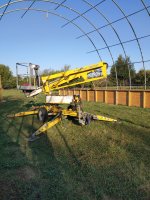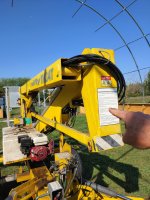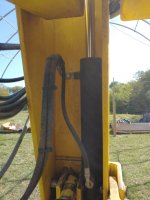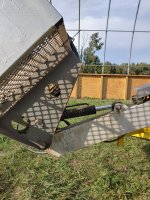Is it possible to pressurize a hydraulic system to some low value to help locate a leak in the suction lines? I was thinking of fabricating a cap for the oil reservoir that will have a shrader valve in it so I can hook a compressor to it and put some low pressure (5-10psi?) in the system to find a leak. The reason I want to do this is in the next paragraph.
I've got an aerial lift, hydraulic circuit attached. The problem symptom is that the cage constantly goes out of level, and also moves out of level on it's own even when the system isn't running. In the circuit diagram the cage leveling cylinders are in the lower center area of the drawing, there is a cage cylinder and a knuckle cylinder. The bleed procedure given in manual is to cycle the cage cylinder fully in both directions, holding it at each extreme position for 20 seconds before releasing pressure. That works, the cage leveling operates properly for some time, generally an hour or two. But then the problem recurs. So I assume it's sucking air in the suction lines. I've tightened the fittings, the hoses are relatively new. I'm trying to figure out how to diagnose the problem before I just start replacing hoses and fittings with no idea what the problem is.
I've got an aerial lift, hydraulic circuit attached. The problem symptom is that the cage constantly goes out of level, and also moves out of level on it's own even when the system isn't running. In the circuit diagram the cage leveling cylinders are in the lower center area of the drawing, there is a cage cylinder and a knuckle cylinder. The bleed procedure given in manual is to cycle the cage cylinder fully in both directions, holding it at each extreme position for 20 seconds before releasing pressure. That works, the cage leveling operates properly for some time, generally an hour or two. But then the problem recurs. So I assume it's sucking air in the suction lines. I've tightened the fittings, the hoses are relatively new. I'm trying to figure out how to diagnose the problem before I just start replacing hoses and fittings with no idea what the problem is.




